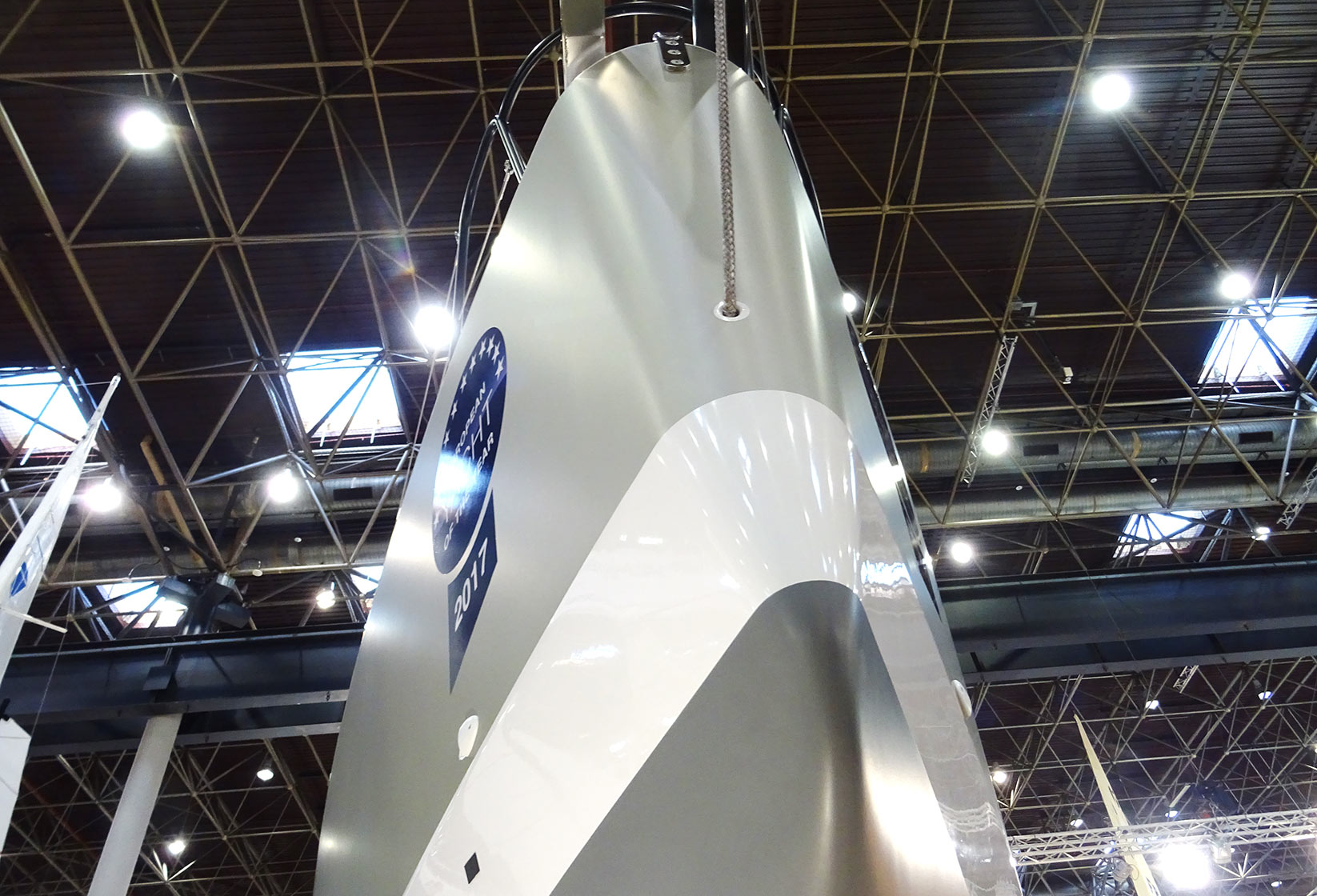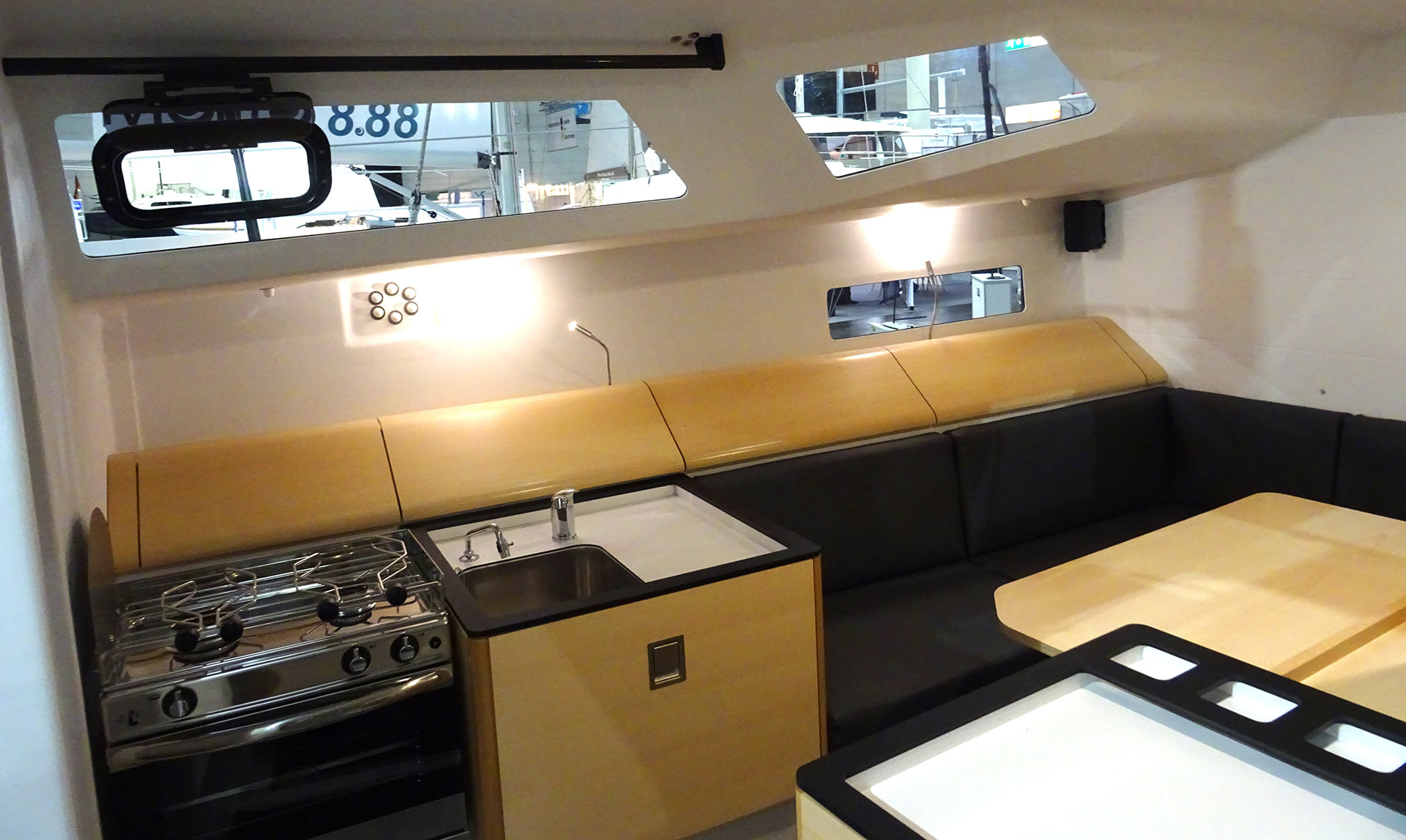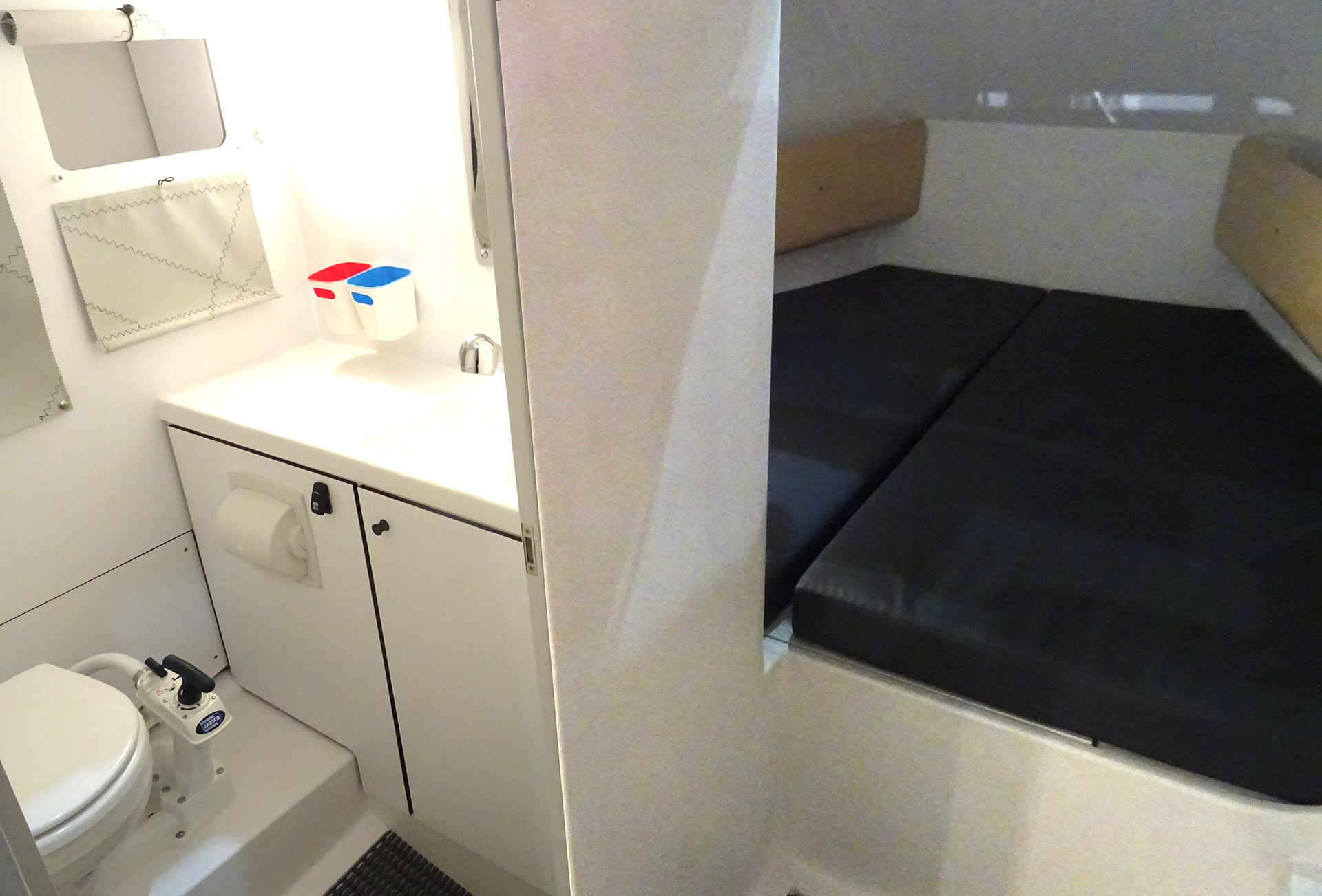Sailing a Pogo yacht is truly unique. These boats are unlike others: Light. Very light. Wide. Very wide. A tiller, of course slightly over canvassed and brutally agile. Pogo yachts are big jolly boats: Very responsive, very fast. Did I say fast? They are ridiculously fast. I tried it multiple times on the very first Pogo, the Pogo 40S, grand-grandfather of the brand new Pogo 36 that was shown on Boatshow Dusseldorf.
About the Pogo 36 in general
No Frills Sailing.com | Lars Reisberg: “Charly, first of all congratulations to this new boat. The whole industry is somehow talking about her. As this is a 36 footer, can you tell me what´s new about the boat?”
Charly Fernbach: “The new Pogo 36 is above all a logical step of evolution in our yard´s line of yachts. She is not a completely new boat but incorporates a lot of lessons learned from our previous models.”

As I roam the halls at Dusseldorf Boat Show (read here my general overview) I was – like almost everybody at the show – keen on seeing the big names, big brands and big boats of course. But next to Hall 16, where the grand names had their huge stands, another hall was filled with the small players and their (mostly) boats. Small players?

The yard from France called Pogo Structures isn´t that small, especially when it comes to the legacy of their boats. For the knowing people the sound of the name “Pogo” makes heartrates go faster and eyes become wet. In short: Pogo boats are legend. I was lucky to meet Monsieur Charly Fernbach at the stand, the notorious face of the French yard Pogo Structures who gave me a tour of the all-new racing cruiser.
Charly Fernbach´s Top 5 about the Pogo 36
The new Pogo 36 will substitute the Pogo 10.50 cruiser. But it is far more than just a replacement or refurbished model. With a LoA of 10.85 metres, a width of 4.00 metres and a draft of 2.95 metres the measurements of the new boat are slightly bigger than of its predecessor. Completely new lines and a distinctive superstructure make it easily recognizable.

NFS.com: “Tell me about, let´s say, your personal Top 5 features of the new Pogo 36 in terms of those new things.”
Charly Fernbach: “First of all there are the rudder blades and tiller touch. A lot of effort went into the improvement of their efficiency when sailing: good feeling & control from 0.5 knots speed to over 20 knots and from upwind to downwind.”
NFS.com: “You mentioned upwind performance. That´s what I would say is the achille´s heel of wide-stern planing yachts like the Pogo …”
Charly Fernbach: “Comparing the Pogo 10.50 from the year 2007, we made a lot of smaller and some bigger changes to the hull to furthermore improve upwind and light wind performance. When we did the sea trials during the European Yacht Of The Year against the J-112 our Pogo had a little superior performance in terms of pointing and speed in 10 knots of wind. Compared to the Pogo 40, a boat from the year 2005 – this new Pogo 36 is a better yacht. She is much more versatile. The Pogo 36 will plane early and overall we managed to fix some other difficulties that aroused in older boats.”

More volume in the bow
NFS.com: “In what respects?”
Charly Fernbach: “Take a look at the bow. It´s far less sharply formed. We added volume here. If you´ve got a sharp thin bow it will cut into the waves. Especially when heeling and sailing upwind older boats had the tendency to dive their nose into the water which gave the crew the hell of a ride but overall was a loss of speed and comfort.”

Indeed, when I rounded the hull from the outside I was amazed by the unfamiliar new shape of the bow. Not exactly what you´ve seen in other – mostly production and big volume boats – where the bow has a hard flat leading edge. A measure to increase the inside volume. With Pogo 36 the leading edge is no edge at all – it´s a full, round and nicely shaped curve that will increase diameter ever so slightly when you reach up the hull to the tip. Not as radical as the proposed scow bow as seen in some Classe Mini Prototypes but visibly broader.

NFS.com: “What does more volume do then?”
Charly Fernbach: “It will add buoyancy if you want. It will add a tendency of the bow to stay above the water. It is increasing the power of the hull and so its resistance to the wind. This will induce more speed. But it is also giving a better hydrodynamic flow of water to the keel reducing drag and increasing efficiency. Also, if the helmsman has more control over the boat it will surely add confidence.”
About interior design and fittings of the Pogo 36
When I was sailing the grand-grand-father of this new Pogo 36 around the Islands of Helgoland and the Danish Fyn (read it here and here) our Skipper told some stories of guests who, upon seeing the Pogo´s interior, straight forward left the boat and never came back again. Speaking flat: Pogo´s approach to interior design is not of the one of timber, veneers, teak and classic design. But of weight saving. Means: Bare GRP and topcoat. I was keen upon seeing what the new Pogo 36 would be offering in these terms.

NFS.com: “Charly, sailing with a Pogo is also special in terms of “comfort” as Pogo Structures has a very own definition of the word “interior design”, as to put it this way …”
Charly Fernbach: (is laughing) “To achieve a lightweight boat the treatment of the inside is sober and elegant. But not “bling-bling”. More than filling the yacht with luxurious elements of the fittings, two major aspects are most important for us here: Lightness of course and ergonomics. Besides: Comparing the Pogo 10.50 you will find a proper bathroom on the Pogo 36.”

NFS.com: “… with a door?”
Charly Fernbach: “… yes, with a proper door. Seriously, a boat needs to be lightweight and powerful in order to be able to plane. That´s a very easy equation, at least on paper. But we tried to make the yacht a bit more appealing at least. An important topic for a real sailing yacht from our point of view is a tryptic of ergonomics, functionality and easy maintenance.”
And here I am, standing inside this huge proper saloon. Yes, there is a lot less wooden fittings to be found in here, but the quality of the ones I saw was convincing. The boat is extremely light-suffused which comes from the clever allocation of the windows in the superstructure of the boat. A huge dining table in the middle of the settees remind me of the cosy evenings in harbours aboard the Pogo 40.

I love the modern navigation station which will be adored by sailors for sure, the proper galley is big enough to prepare meals for the crew. The mentioned head in the fore cabin with a proper door is a definitive step forward for Pogo. In the end, I was puzzled – as always when entering a Pogo – by the amount of room inside this 36 foot long boat. Which is easily comparable to the space of a 40 to 42 foot yacht.
On Pogo 36 sailing abilities
NFS.com: “The name Pogo is above all a harbinger of speed. I can remember being aboard one of your boats under sails and the crew was staring at the speedometer: Everything below 10 knots was a kind of disappointment it seemed. So speed is the main attribute – tell me more about the sailing performance of the new Pogo 36.”
Charly Fernbach: “At first: The Pogo 36 as a breed of Structures is a fast sailing yacht for sure. She is fast, responsive and very agile. She is above all easy to sail fast. She loves light wind conditions as well as strong winds. As one of the latest generation offshore boats her mast is stepped more on the rear to offer a relatively narrow main sail – which is more efficient – and bigger angle of stay to generate nose lifting at reaching angles of sailing.”

NFS.com: “No backstays here?”
Charly Fernbach: “No, completely different from the Class 40 racer you know. Pogo 36 is a real cruising boat. She has to be accessible and safe. So with the carbon mast the boat simply doesn´t need a backstay.”
On Class 40 racing yachts
NFS.com: “You mentioned Class 40. Pogo Structures offers the S3 in their range of very successful pure racers. What´s about the Class itself?”
Charly Fernbach: “With just 10 years the Class 40 is still young.”
NFS.com: “Can you explain that?”

Charly Fernbach: “Well, like basically everything, a class has life cycle too. When it is introduced, boats are affordable and people come to the class to have fun there. Back then, some 10 years or so ago, a Class 40 sailing yacht would cost some 140.000 Euros. Now the class gets more and more competitive and the last details to increase the performance are often really expensive. Now some teams will spend more than 500.000 Euros for Class 40 racing yachts itself. I think that it is important to keep nonprofessional sailors on the fleet of Class 40 by keeping the cost for boats reasonable. This is important for the future.
NFS.com: “So Structures will abandon the Class 40 concept?”
Charly Fernbach: “No, not at all. With our Classe Mini and Class 40 we have a line of pure offshore racers. For us as a company this is a platform for development to make fast cruisers, such like the Pogo 12.50 and this new Pogo 36.
NFS.com: “That means?”
Charly Fernbach: “Take the Route du Rhum. After such a very hard race the boats will have undergone the harshest testing conditions you can imagine. You cannot reproduce those conditions in test scenarios in your home bay. So after such a race we see where the weak points are and what we can improve both for the racing yachts and our fast cruisers. Just like Formula One for a carmaker, regatta racing is our testbed.”

NFS.com: “Charly, thanks so much for answering my questions and giving an exclusive insight in the latest developments of Pogo Structures.”
So I leave the small stand of Pogo Structures. Take a last look at the small Pogo 36. And I know, that this might be one of the biggest boats whatsoever of the whole show, a real star of the fleet and probably one of the most exciting boats of the fair. I´d love to see her sailing – and when imagining the boat running two digit speeds downwind I can clearly see myself at the helm. Smiling bright and happy.
Browse all articles related to the Boatshow Dusseldorf by clicking this #boatshowdusseldorf hashtag.
Other interesting articles on that topic:
Gennaker sailing a Class 40
Merfyn Owen, Britton Ward and Marc Lombard on Class 40 racing yachts
Lizzy Foreman on her MiniTransat race 2015
